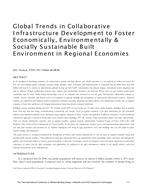
Global Trends in Collaborative Infrastructure Development to Foster Economically, Environmentally & Socially Sustainable Built Environment in Regional Economies
- Comments Off on Global Trends in Collaborative Infrastructure Development to Foster Economically, Environmentally & Socially Sustainable Built Environment in Regional Economies
- ASHRAE
Click here to purchase
In the developed or developing economies, the infrastructure systems and their effective and reliable operation is a pre-requisite for delivery of services for HVAC and building systems including associated energy, mobility, water, sanitation, and communication. It is projected that by 2030, more than $50 trillion will need to be invested in infrastructure globally to keep up with GDP, urbanization and climatic changes. Investments of this magnitude can only be delivered through collaboration between cities, regions, and international businesses and investors. Where there are gaps between public funds availability and the needs, Public-Private-Partnerships need to be evaluated and structured to close the gaps. International collaboration common in scientific research, education and finance need to be transposed to capacity building and management of multi-faceted infrastructure projects. Advanced countries can collaborate with regional country counterparts to projects execution, financing and timely delivery. Geo-collaboration enables cities in regional economies to boost their effectiveness by bringing international know-how directly to projects facilitators.Buildings systems including lighting and HVAC consume nearly 40% of total energy use. To lower their carbon footprint, buildings need to perform better than they had been doing, environmentally, economically and socially. Need in regional economies is for open innovations for self sustainable habitats with minimum pollution levels, optimized energy supplies, adequate security, scalable and adaptable to different situations. A well coordinatedcollaborative approach is favored to benefit from nexus between smart buildings, HVAC systems, IAQ, environment, power and water infrastructure. There are already collaborative activities, such as regional satellites, regional countries collaboration, National League of Cities, C40 Cities, 100 Resilient Cities, Future-Cities-Collaborative for shared benefits. In the future, the combination of power, water and communications infrastructure with real time data analytics and potential use of Artificial Intelligence will bring us high performance cities and buildings that can also adopt to global weather changes and emergencies.This paper presents a conceptual framework for development of robust, and resilient infrastructure to suit the needs of regional economies along with fostering skills and job creation. A new approach of using open innovation with a geo-collaborative vision, knowledge, skills, experience and strategies for effective and sustainable delivery of services, goods and policies is discussed. Technologies need to be adapted to serve local needs commensurate with global experiences, to ensure that the right technologies and applications are employed in the right environments, tailored to the specific cultural, social and economic characteristics of the individual city.
Citation: 3rd Intl Conf: Efficient Bldg Design
Product Details
- Published:
- 2018
- Number of Pages:
- 8
- Units of Measure:
- Dual
- File Size:
- 1 file , 1 MB
- Product Code(s):
- D-ICEB18-C014

